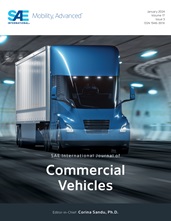This paper presents a combined aero-thermal computational fluid dynamic (CFD)
evaluation of platooning medium duty commercial vehicles in two highway
configurations. Thermal analysis comparison is made between an approach that
includes vehicle drag reduction on engine heat rejection and one that does not
by assuming a constant heat rejection based on open road conditions. The paper
concludes that accounting for aerodynamic drag reduction on engine heat load
provides a more real world evaluation than assuming a constant heat load based
on open road conditions.
A 3D CFD underhood thermal simulations are performed in two different vehicle
platooning configurations; (i) single-lane and (ii) two-lane traffic conditions.
The vehicle platooning consists of two identical vehicles, i.e. leading and
trailing vehicle.
In this work, heat exchangers are modeled by two different heat rejection rate
models. In the first model, a constant heat rejection rates are considered as
similar to no-traffic vehicle condition. In the other model, a varied heat
rejection rates are implemented by considering an aerodynamic influence on fuel
consumption rates.
In a constant heat rejection rate model, the trailing vehicle thermal performance
is significantly dropped in single-lane traffic due to reduced oncoming cold
mass air flow velocities from leading vehicle. Also, the similar observations
are found in two-lane traffic but at higher vehicle separation distances.
In a varied heat rejection rate model, significant drop in temperature raise is
observed in both leading and trailing vehicles when compared to a constant heat
rejection rate model in the single-lane and the two-lane traffic conditions. In
leading and trailing vehicles, the varied heat rejection rates are obtained from
fuel consumption rates.
